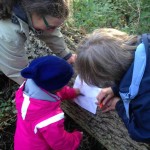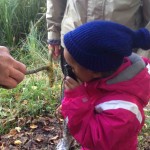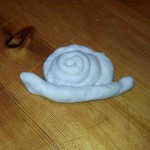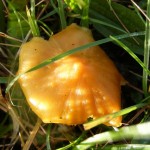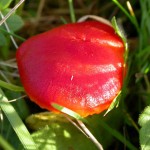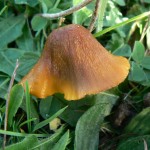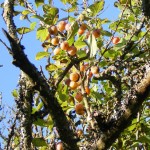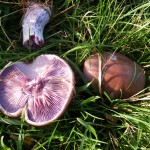The family walk on Saturday 2nd November at Moor Copse, a reserve of the Berkshire, Buckinghamshire and Oxfordshire Wildlife Trust (BBOWT) in the lower Pang valley near Tidmarsh, was a new venture for the Society. One young family came with grandparents and were looked after by Ricki Bull. They used a hand lens to inspect the lichens on fallen twigs, saw an interesting collection of fungi and found 3 different kinds of snail, including long, thin spiral door snails, which can be seen on some of the trees. They did some bark rubbing and enjoyed a game of Pooh Sticks on the bridge over the Pang.
Other members walked round the reserve in a separate group. Although it was already November, the predominant colour was green – few trees had started to take on autumn colours. The leaves of a Wych Elm, found at the side of the lane near the car park, were compared with the much commoner Hazel. Bright red berries of Black Bryony were growing in a twisted strand, draped over the hedge at the side of the track leading into the meadows. More Wych Elm was found in the hedge. A few flowers could still be seen in the meadows, including Meadow Buttercup, Common Knapweed, Devil’s-bit Scabious and, in the wetter parts of Corner Field, Creeping Cinquefoil. Earlier in the summer, the Moor Copse meadows were chosen to be the Coronation Meadow for Berkshire and volunteer Reserve Warden Anne Booth was invited, with representatives of the best meadows from across the country, to Highgrove House for a reception to celebrate 60 years since the Queen’s coronation.
A thicket of Bullace trees grows next to the site of the former cottage in Cottage Field. The trees had a heavy crop of sweet orangeish-pink plums, which were enjoyed by many of the group. Highlights of the afternoon were the wax-cap fungi on the drier gravel terraces in Corner Field. A few were yellow, white or orange, but most were bright red. Many were just beginning to poke up out of the grass. Wax-caps are colourful fungi of unimproved grassland with short turf – the hay-making with aftermath grazing regime at Moor Copse obviously suits their needs. Wood Blewits were growing out of a pile of old hay, which had been left at the side of the field from a previous year. A little mouse jumped away as people moved closer to inspect the fungi. The walk continued along the footpath to Sulham Brook, where a large Ash had been felled by the gales at the beginning of the week. A surprisingly small amount of roots had been uncovered when it fell. Bush Vetch and Herb Robert were in flower beside the path.
The route then doubled back and crossed Barton’s Field, where there was a badger latrine in a hole at the side of path. Entering Moor Copse, the puff-ball Lycoperdon pyriforme was found growing in clumps on dead wood. More wax-caps were found in 5-Acre Field. In Park Wood, the group inspected some of the recent coppice plots to see how the stumps had been protected from browsing deer and how quickly the trees were growing back. Earlier in the season, the coppice plot from 2 winters back had been outstanding for flowers and butterflies. Continuing to the main ride, there were waxy red berries on the Guelder-rose bushes and abundant pink berries on the Spindle bushes. The group then walked back along the river bank to the car park.
Pictures by Rob Stallard, Laurie Haseler and Jan Haseler

